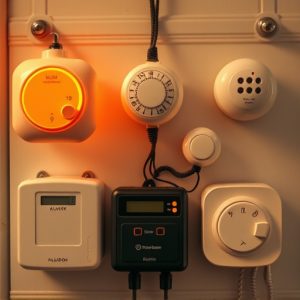GPS Tracking Self-Defense Devices: Benefits, Practices & Ranges
GPS-enabled self-defense devices offer revolutionary safety features, especially within buildings wh…….
GPS-enabled self-defense devices offer revolutionary safety features, especially within buildings where traditional alarms have limited reach. By providing real-time location tracking and automatic fall detection, these tools enhance emergency response times. To maximize their effectiveness, users should understand device limitations like signal dependency on clear line-of-sight to the sky, thick walls, or multiple floors reducing range and accuracy. Regular testing ensures informed decision-making during emergencies, leading to faster authority responses.
Staying safe while navigating bustling cities or even within your own home is paramount. Self-defense devices equipped with GPS tracking offer a revolutionary game-changer, providing peace of mind and empowerment. This article explores how these innovative tools, like GPS-enabled personal alarms, enhance security. We delve into their benefits, key features, and best practices for optimal use in various settings, including buildings, to ensure maximum protection. Understanding the capabilities of self-defense devices with GPS tracking is essential in today’s digital era.
- Understanding Self-Defense Devices with GPS Tracking
- Benefits and Features of GPS-Enabled Personal Alarms
- Best Practices for Using GPS Self-Defense Tools in Buildings
Understanding Self-Defense Devices with GPS Tracking
Self-defense devices equipped with GPS tracking technology represent a significant advancement in personal safety. These innovative tools go beyond traditional self-defense mechanisms, offering users an added layer of security and peace of mind. By integrating Global Positioning System (GPS) capabilities, these devices enable individuals to discreetly call for help from virtually anywhere, ensuring swift assistance during emergencies. The GPS functionality is particularly beneficial in enclosed spaces or remote areas where the personal alarm’s range might be limited.
With a simple activation, these self-defense gadgets can transmit an individual’s location data to pre-selected emergency contacts or local law enforcement agencies. This real-time tracking feature is invaluable when facing threats, as it allows users to stay connected and guide responders to their exact position, even within large buildings or dense urban environments where personal alarm range might be hindered by structural obstacles.
Benefits and Features of GPS-Enabled Personal Alarms
GPS-enabled personal alarms offer a revolutionary approach to self-defense, providing users with an added layer of safety and peace of mind. One of the primary benefits is their ability to track location, especially in enclosed spaces where traditional signals might be compromised. This feature ensures that emergency services can swiftly locate the wearer, making it invaluable in situations requiring quick response times, such as in buildings with poor signal penetration.
These devices boast advanced technology, including GPS tracking, mobile app connectivity, and automatic fall detection. The personal alarm range within buildings is significantly enhanced due to these features. Users can rest assured that they can call for help even if they are unable to physically reach a phone or a window. Additionally, some models offer real-time location sharing with trusted contacts, enabling friends and family to monitor the user’s safety during their daily activities.
Best Practices for Using GPS Self-Defense Tools in Buildings
When utilizing GPS self-defense tools within buildings, it’s crucial to understand their limitations and optimal usage. These devices can be highly effective for personal safety, but their effectiveness depends on several factors, especially in enclosed spaces where signals might be obstructed. One of the key considerations is maintaining a clear line of sight to the sky, as GPS signals rely on satellites. In buildings with thick walls or multiple floors, the personal alarm’s range may be reduced, and the device might not always pinpoint your exact location accurately.
To mitigate these issues, ensure that you carry the device openly, allowing it to transmit signals unobstructed. Positioning windows or outdoor areas in your line of sight can significantly improve GPS accuracy. Regularly test the device’s functionality, including the GPS tracking feature, to ensure it operates as intended. Understanding your device’s specifications and range will empower you to make informed decisions during an emergency, ensuring a faster response from authorities.
Self-defense devices equipped with GPS tracking offer a robust solution for personal safety, especially when indoors. By leveraging these tools, individuals can gain peace of mind knowing their location is accessible to emergency services. The benefits extend to enhanced situational awareness and improved response times during emergencies, making GPS-enabled personal alarms a valuable asset in various environments. When used appropriately, these devices can significantly improve personal security, particularly within buildings where the personal alarm range is crucial for effective communication and assistance.


